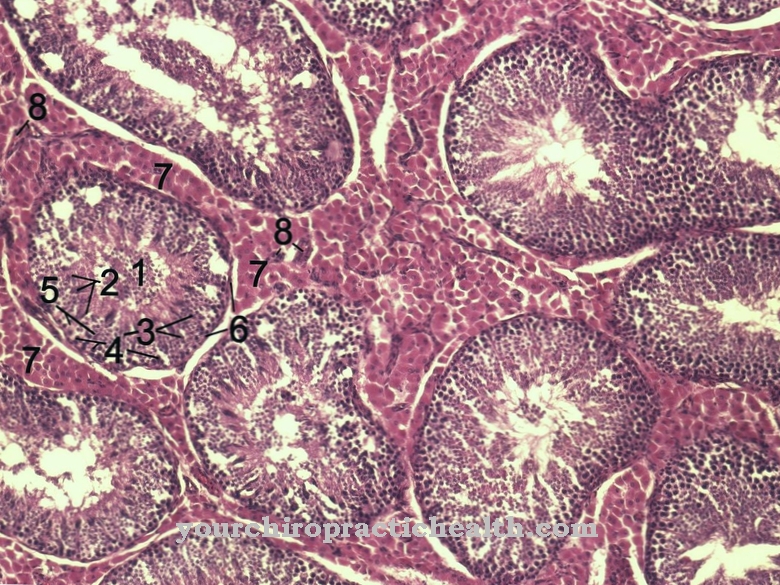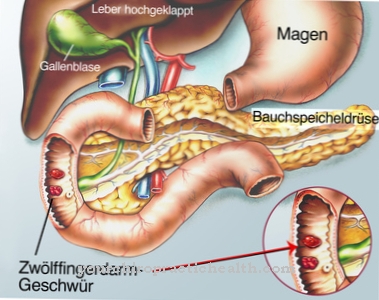In the Brachial artery it is an arterial blood vessel. The artery is comparatively large and is located in the upper arm.
The brachial artery attaches to and continues the axillary artery. The name of the artery changes at the lower edge of the tendon of a special muscle, namely the teres major muscle. Finally, the brachial artery divides into the radial artery and the ulnar artery.
What is the brachial artery?
In many cases the brachial artery is also called something Humerus artery designated. It is an artery in the area of the upper arm that is responsible for the blood supply to the entire arm. In doing so, it continues the axillary artery called the axillary artery, which is located in the inner groove of the biceps. So it lies in the inner side of the biceps brachii muscle. Under the elbow, the brachial artery divides into two other arteries, the ulnar artery and the radial artery.
Basically, the brachial artery is accompanied by certain nerves on both sides. These nerves belong to the fascicle in the arm plexus. In the medial direction, these are the median nerve, the ulnar nerve, the medial antebrachial cutaneous nerve and the medial cutaneous brachial nerve.Next to the brachial artery below the biceps is the musculocutaneous nerve. It is also important that the blood pressure is measured with a stethoscope at the point where the brachial artery divides. The pulse can also be felt in this area. Especially in newborns or small children, the pulse is easier to determine here than on the wrist.
Anatomy & structure
At the beginning of its course, the deep brachial artery splits off from the brachial artery. This then runs together with the radial nerve and initially with the axillary nerve. These nerves extend from the fascicle of the brachial plexus over the triceps brachii muscle.
They rise above the elbow and at this point run between the brachioradialis muscle and the brachialis muscle. In the area of the elbow, the blood from the deep brachial artery mixes again with the blood from the brachial artery. This mixture occurs through the network of blood vessels located in the crook of the elbow. However, if the brachial artery is relocated, the collateral artery alone is not able to permanently supply the arm with sufficient blood and oxygen. The vein accompanying the brachial artery is called the brachial vein. The section where the brachial artery passes through the cubital fossa is called the cubital artery.
Later, the brachial artery stretches along the intermuscular septum and finally runs almost without any padding along the bone to the cubital fossa. It then passes through the cubital fossa. The brachial artery runs under the aponeurosis in the area of the biceps brachii muscle and divides into its terminal branches. The two main branches of the brachial artery are the radial arteries and the ulnar arteries. Its secondary branches are the superior ulnar collateral artery, the profunda brachii artery and the inferior ulnar collateral artery. In addition, there are other branches to various supply areas in the vicinity of the artery.
Function & tasks
Since the brachial artery is an artery in the area of the upper arm, it is primarily responsible for supplying the arm with blood. Central here is the transport of oxygen and various nutrients to different sections of the arm. The brachial artery interacts with other arteries and veins. In addition, the brachial artery has numerous small ramifications and branches that supply other areas with blood and oxygen.
You can find your medication here
➔ Medicines for painDiseases
In connection with the brachial artery, complaints and diseases sometimes occur, some of which can lead to serious complications. The brachial artery runs very close to the humerus. Because of this, if the upper arm fractures, the artery is particularly prone to injury.
Damage to the brachial artery is not uncommon in such cases and affects the blood supply to the affected arm. On the other hand, the proximity to the humerus is also a positive aspect. This consists in the fact that the artery is relatively easy to compress in the event of distal damage to the arm. This will help prevent large amounts of blood from being lost.
There is also the option of squeezing the brachial artery within the groove of the muscle in the event of bleeding in the lower arm. If punctures are made on the veins around the elbow, there is a risk of accidentally puncturing the brachial artery. The more atypical the course of the brachial artery in the affected person, the greater the risk. In general, injuries to the brachial artery or bruises during their course urgently require medical treatment. If the artery is injured, it cannot adequately fulfill its function as an artery. The blood supply to the injured arm should, however, be maintained without long interruptions if possible.
























.jpg)



